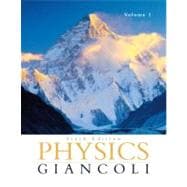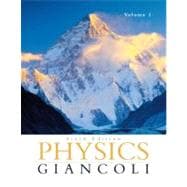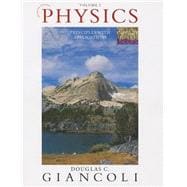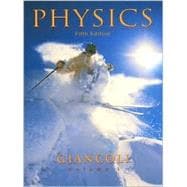Physics Principles with Applications Volume I (Ch. 1-15)

Physics Principles with Applications Volume I (Ch. 1-15)
- ISBN 13:
9780130352569
- ISBN 10:
013035256X
- Edition: 6th
- Format: Paperback
- Copyright: 01/07/2004
- Publisher: Addison-Wesley
- Newer Edition
Note: Supplemental materials are not guaranteed with Rental or Used book purchases.
Extend or Purchase Your Rental at Any Time
Need to keep your rental past your due date? At any time before your due date you can extend or purchase your rental through your account.
Summary
See the World through Eyes that Know Physics
This book is written for students. It has been written to give students a thorough understanding of the basic concepts of physics in all its aspects, from mechanics to modern physics. It aims to explain physics in a readable and interesting manner that is accessible and clear, and to teach students by anticipating their needs and difficulties without oversimplifying. A second objective is to show students how useful physics is in their own lives and future professions by means of interesting applications. In addition, much effort has gone into techniques and approaches for solving problems.
This textbook is especially suited for students taking a one-year introductory course in physics that uses algebra and trigonometry but not calculus. Many of these students are majoring in biology or (pre)medicine, and others may be in architecture, technology, or the earth or environmental sciences. Many applications to these fields are intended to answer that common student query: "Why must I study physics?" The answer is that physics is fundamental to a full understanding of these fields, and here they can see how. Physics is all about us in the everyday world. It is the goal of this book to help students "see the world through eyes that know physics."
NEW: Some of the new features in this sixth edition include (1) in-text Exercises for students to check their understanding; (2) new Approach paragraphs for worked out Examples; (3) new Examples that step-by-step follow each Problem Solving Box; (4) new physics such as a rigorously updated Chapter 33 on cosmology and astrophysics to reflect the latest results in the recent "Cosmological Revolution"; and (5) new applications such as detailed physics-based descriptions of liquid crystal screens (LCD), digital cameras (with CCD), and expanded coverage of electrical safety and devices. These and other new aspects are highlighted below.
Physics and How to Understand It
I have avoided the common, dry, dogmatic approach of treating topics formally and abstractly first, and only later relating the material to the students' own experience. My approach is to recognize that physics is a description of reality and thus to start each topic with concrete observations and experiences that students can directly relate to. Then we move on to the generalizations and more formal treatment of the topic. Not only does this make the material more interesting and easier to understand, but it is closer to the way physics is actually practiced.
A major effort has been made to not throw too much at students reading the first few chapters. The basics have to be learned first; many aspects can come later, when the students are more prepared. If we don't overwhelm students with too much detail, especially at the start, maybe they can find physics interesting, fun, and helpful-and those who were afraid may lose their fear.
The great laws of physics are emphasized by giving them a tan-colored screen and a marginal note in capital letters enclosed in a rectangle. All important equations are given a number to distinguish them from less useful ones. To help make clear which equations are general and which are not, the limitations of important equations are given in brackets next to the equation.
Mathematics can be an obstacle to student understanding. I have aimed at including all steps in a derivation. Important mathematical tools, such as addition of vectors and trigonometry, are incorporated in the text where first needed, so they come with a context rather than in a scary introductory Chapter. Appendices contain a review of algebra and geometry (plus a few advanced topics: rotating reference frames, inertial forces, Coriolis effect; heat capacities of gases and equipartition of energy; Lorentz transformations). Systeme International (SI) units are used throughout. Other metric and British units are defined for informational purposes.
Chapter 1 is not a throwaway. It is fundamental to physics to realize that every measurement has an uncertainty, and how significant figures are used to reflect that. Converting units and being able to make rapid estimates are also basic. The cultural aspects at the start of Chapter 1 broaden a person's understanding of the world but do not have to be covered in class.
The many applications sometimes serve only as examples of physical principles. Others are treated in depth. They have been carefully chosen and integrated into the text so as not to interfere with the development of the physics, but rather to illuminate it. To make it easy to spot the applications, a Physics Applied marginal note is placed in the margin.
Color is used pedagogically to bring out the physics. Different types of vectors are given different colors (see the chart on page xxv). This book has been printed in 5 colors (5 passes through the presses) to provide better variety and definition for illustrating vectors and other concepts such as fields and rays. The photographs opening each Chapter, some of which have vectors superimposed on them, have been chosen so that the accompanying caption can be a sort of summary of the Chapter.
Some of the new aspects of physics and pedagogy in this sixth edition are:
- Cosmological Revolution: The latest results in cosmology and astrophysics are presented with the generous help of top experts in the field. We give readers the latest results and interpretations from the present, ongoing "Golden Age of Cosmology."
- Greater clarity: No topic, no paragraph in this book was overlooked in the search to improve the clarity of the presentation. Many changes and clarifications have been made, both small and not so small. One goal has been to eliminate phrases and sentences that may slow down the principle argument: keep to the essentials at first, give the elaborations later.
- NEW: Vector notation, arrows: The symbols for vector quantities in the text and Figures now have a tiny arrow over them, so they are similar to what a professor writes by hand in lecture. The letters are still the traditional boldface: thus v for velocity, F for force.
- NEW: Exercises within the text, for students to check their understanding. Answers are given at the end of the Chapter.
- NEW: Step-by Step Examples, after a Problem Solving Box, as discussed on page xvii.
- Conceptual Examples are not a new feature, but there are some new ones.
- Examples modified: more math steps are spelled out, and many new Examples added: see page xvii.
- Page layout: Complete Derivations. Even more than in the previous edition, serious attention has been paid to how each page is formatted. Great effort has been made to keep important derivations and arguments on facing pages. Students then don't have to turn back and forth. Throughout the book readers see before them, on two facing pages, an important slice of physics.
- NEW: Subheads: Many of the Sections within a Chapter are now divided into subsections, thus breaking up the topics into more manageable "bites." They allow "pauses" for the students to rest or catch their breath.
- NEW: Marginal notes: Caution. Margin notes, in blue, point out main topics actin as a sort of outline and as an aid to find topics in review. They also point out applications and problem-solving hints. A new type, labeled CAUTION, points out possible misunderstandings discussed in the adjacent text.
- Deletions. To keep the book from being too long, and also to reduce the











